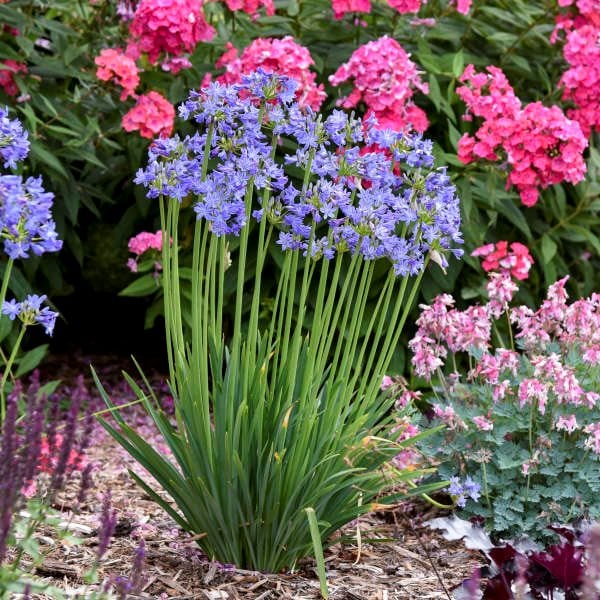Agapanthus Propagation: Tips for Expanding Your Plant Collection
Agapanthus Propagation: Tips for Expanding Your Plant Collection
Blog Article
Understanding the Art of Agapanthus Care: Essential Steps for Healthy Growth and Lively Blossoms
In the world of horticulture, the cultivation of agapanthus stands as a gratifying venture for those who look for to nurture these elegant blooming plants. From choosing the best selection to mastering pruning strategies, the journey towards growing flourishing agapanthus plants is multifaceted and holds the key to opening the complete capacity of these herb gems.

Selecting the Right Agapanthus Variety

When picking the best Agapanthus range for your yard, think about factors such as environment viability, bloom color, and growth routine. Agapanthus, commonly referred to as Lily of the Nile or African lily, can be found in a range of colors varying from shades of purple and blue to white. Select a blossom shade that enhances your existing yard combination to develop a harmonious landscape. Additionally, take into consideration the environment in your region to make certain the Agapanthus selection you select can thrive in your specific problems. Some ranges are more forgiving of cold temperatures, while others favor warmer climates. Understanding the growth practice of different Agapanthus varieties is important for appropriate positioning within your yard. Some selections have a clumping growth habit, perfect for borders or containers, while others have a more spreading nature, ideal for ground cover or mass plantings. By thoroughly evaluating these aspects, you can pick the excellent Agapanthus selection to improve the beauty of your yard.
Ideal Planting Problems
Thinking about the optimal environmental needs is vital for effective Agapanthus cultivation. Agapanthus grows in well-draining soil with a slightly acidic to neutral pH level. When planting, choose a place that receives full sunlight to partial color. In hotter climates, offering some mid-day shade can protect against scorching of the leaves. Agapanthus plants are delicate to cold temperatures and should be secured from frost throughout winter months.
To make sure healthy growth and vibrant blossoms, plant Agapanthus light bulbs at a deepness of concerning 2-4 inches and area them 8-12 inches apart. Mulching around the base of the plants assists retain dampness and suppresses weed development.
Watering and Fertilizing Tips
Keeping appropriate dampness levels and giving essential nutrients are essential aspects in the treatment routine for Agapanthus plants. When it comes to watering Agapanthus, it is essential to strike a balance. These plants choose consistently moist dirt but are prone to root rot if overwatered.
Fertilizing Agapanthus is crucial for promoting healthy growth and respected blooms. Apply a balanced fertilizer, such as a 10-10-10 formula, in the early springtime as brand-new development arises. Repeat this application every 6-8 weeks throughout the expanding period. Avoid extreme fertilization, as it can bring about lush foliage at the cost of blossoms. Constantly adhere to the supplier's guidelines for correct dilution and application methods. By following these watering and fertilizing suggestions, you can ensure your Agapanthus plants flourish and create lively, lasting blooms.
Trimming Methods for Agapanthus
Pruning Agapanthus plants at the suitable times and with proper strategies is essential for maintaining their health and advertising optimal development and blooming. The excellent time to trim Agapanthus is in late winter season or early spring prior to brand-new growth arises. Begin by eliminating any dead or yellowing leaves near the base of the plant. Cut them as close to the ground as feasible without damaging the arising shoots.
For flowered stems, wait until the flowers have perished and afterwards cut them back to the base. This not Read More Here only cleans up the plant's appearance but likewise encourages the development of brand-new flower buds. Deadheading invested flowers can also reroute the plant's energy right into producing even more flowers as opposed to setting seeds. However, if you wish to accumulate seeds for proliferation, leave some flowers to dry and fully grown on the plant.
Bear in mind to use clean, sharp devices to make exact cuts and lower the risk of presenting illness. Agapanthus. Normal pruning will assist keep your Agapanthus looking healthy and balanced and neat while ensuring a plentiful display of beautiful flowers
Taking Care Of Typical Pests and Diseases
After making sure proper pruning techniques for Agapanthus, it is vital to attend to typical bugs and conditions that can affect the health and wellness and vitality of these plants. One common insect that impacts Agapanthus is the Agapanthus gall midge.
One more common concern is fungal leaf area, which presents as dark sores on the fallen leaves. To stop fungal diseases, guarantee great air flow around the plants, avoid overhead watering, and get rid of like it any type of infected fallen leaves without delay. In addition, Agapanthus plants can suffer from root rot if they are grown in improperly draining soil. To avoid this, plant Agapanthus in well-draining dirt and prevent overwatering. By being attentive and taking timely action against diseases and bugs, you can help your Agapanthus plants grow and create dynamic blooms.

Verdict
Finally, mastering the art of agapanthus care involves selecting the ideal range, supplying excellent growing conditions, appropriate watering and feeding, proper pruning techniques, and dealing with typical insects and illness. By following these vital steps, you can guarantee healthy development and vivid flowers for your agapanthus plants. Keep in use this link mind to consistently check and preserve your plants to promote their overall wellness and durability.
To guarantee healthy development and lively blossoms, plant Agapanthus light bulbs at a depth of about 2-4 inches and room them 8-12 inches apart. By adhering to these watering and fertilizing ideas, you can ensure your Agapanthus plants thrive and generate vibrant, resilient blossoms.
One typical bug that influences Agapanthus is the Agapanthus gall midge. Additionally, Agapanthus plants can endure from root rot if they are planted in inadequately draining dirt. By complying with these vital actions, you can guarantee healthy and balanced growth and vibrant flowers for your agapanthus plants.
Report this page